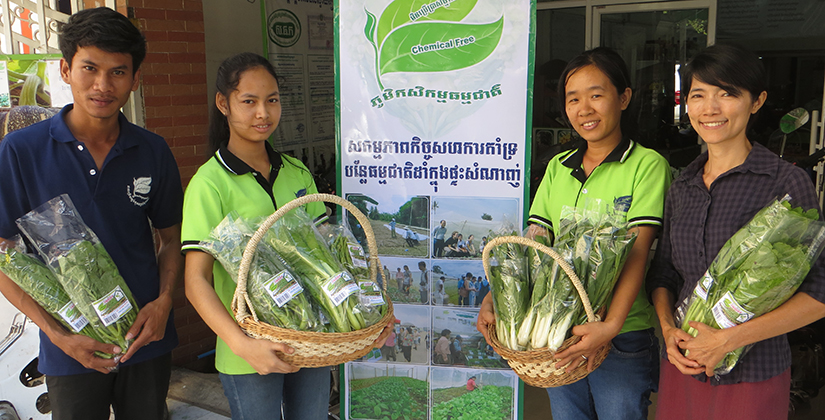
Editor’s note: This blog post by Karen LeGrand was originally a presentation given at the Horticulture Innovation Lab’s 2017 annual meeting.
LeGrand is a UC Davis researcher who helps manage a Horticulture Innovation Lab project focused on building safe vegetable value chains in Cambodia along with an international team from the Royal University of Agriculture, the University of Battambang and iDE Cambodia. Their team builds on lessons learned from a previous project in Cambodia.

What do relationships have to do with innovation and food safety? Our project is built on the idea that when we focus our work around the shared interests of a community, it can bring people together in participatory ways that result in innovation and sustainable change.
One example from the first phase of our project was a situation where a marketer wanted to purchase vegetables that were considered “safe” (free of microbiological and chemical hazards). Farmers participated with our research team to conduct trials aimed at identifying appropriate ways to change farming and postharvest practices to reduce chemical usage and improve hygiene. Our project introduced a variety of technologies to farmers and marketers, who selected pest exclusion nets as a possible solution to reducing or eliminating pesticide usage and improving hygiene. Through participatory trials with our researchers, the farmers adapted the nets to fit their own needs and the marketer gained confidence that farmers using this technology could help meet the market demand for safe vegetables. The marketer agreed to offer a higher price on contract to farmers who properly used net houses to produce vegetables.
As these local community members participated with our research team during field trials, they gained mutual trust and developed strong business relationships that continue today, nearly 3 years after the initial project ended.

The shared interests that motivated participation and built trusted relationships during the project were the key that opened the door to innovation and long-term adoption of safe food practices. Fostering shared interest, participation and trust can…
- … mitigate the risk of change
Communities that work together towards shared goals develop not only a sense of trust, but also of solidarity. This is important because when community members act together, the shared sense of ownership becomes a support system to mitigate the risk of change.
- … improve gender equity
When community members act collectively, there is more gender equity. We see that as women and men participate in our project to solve problems together, women become more active in their communities and even take on leadership roles.
- … increase income
Community members who work together towards common occupational goals have more opportunity to develop strong business relationships, earn more income and save money to invest in their families and businesses.
- …. result in local sustainability
When trusted relationships are fostered among individuals who have shared interests, there is motivation to work together to identify innovative solutions to shared problems. Investments made by local people to solve their own problems build local ownership and sustainability into a project.
- …. improve food safety, health and nutrition
Sustainable improvements in farming and postharvest practices lead to reductions in chemical use and increases in hygienic practices. Food that is free of chemical and microbiological contaminants improves nutrition and health.
Our experience prioritizing shared interest, participation and trust in our work with communities in Cambodia illustrates that ongoing local relationships are key in carrying forward innovation and technology adoption for improving food safety.
Led by a UC Davis team in partnership with the Royal University of Agriculture and the University of Battambang, this project is supported by the Horticulture Innovation Lab with funding from the U.S. Agency for International Development as part of the U.S. government’s global Feed the Future initiative.
More information:
- Project information: Building safe vegetable value chains in Cambodia
- Related blog post & video: Building trust in food systems – here and in Cambodia
- More 5-Minute Lesson blog posts
